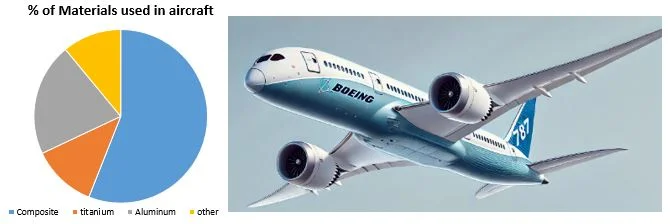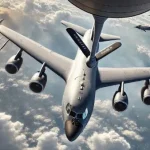Composite materials have revolutionized modern aircraft design. Known for their lightweight, strength, and flexibility, these materials—comprising fibers such as carbon or glass embedded in a matrix (resin)—allow for enhanced performance and fuel efficiency. By reducing the overall weight of an aircraft, composite materials enable manufacturers to increase payloads, reduce fuel consumption, and improve durability.
Types of Composite Materials Used in Aircraft

Commonly used composite materials in aircraft include:
- Carbon Fiber Reinforced Polymer (CFRP): Known for its high strength-to-weight ratio, CFRP is often used in primary structures like wings and fuselages.
- Glass Fiber Reinforced Polymer (GFRP): While less strong than CFRP, GFRP is cost-effective, do not conduct electricity, suitable for transferring radio waves hence used in radomes.
- Aramid Fiber (Kevlar): Aramid is lighter than CFRP and has excellent impact resistance, making it suitable for areas prone to damage.
Trend of composite material usage in aircraft structure
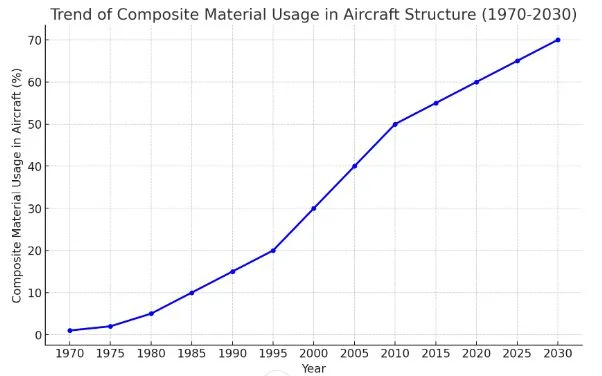
Current Applications
Modern aircraft, such as the Boeing 787 Dreamliner and Airbus A350, integrate over 50% composite materials by weight. Primary applications include wings, tail surfaces, and fuselage sections, where composite materials’ ability to withstand stress while reducing weight proves invaluable. This increasing reliance on composites allows for sleek, efficient designs with fewer fasteners, reducing maintenance needs and weight further.
Future Prospects
The use of composite materials in aerospace is expected to continue growing as materials and manufacturing methods advance. Innovations such as thermoplastic composites, which can be molded and reshaped with heat, open doors to easier repairs and recycling. Additionally, advances in nano-reinforced polymers and hybrid composites promise even lighter and stronger materials for future applications.
Composite material usage in Airbus aircraft
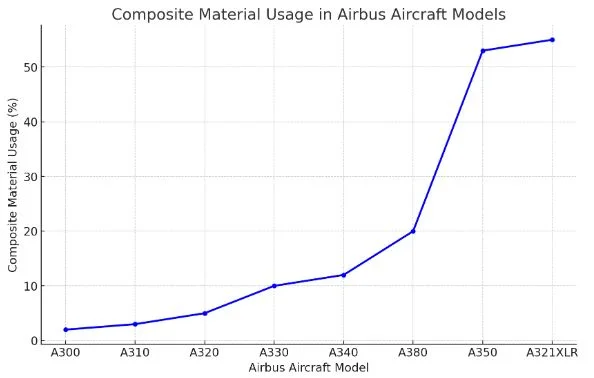
The curve above shows the progression of composite material usage in various Airbus aircraft models. Starting with a modest amount in the A300, Airbus steadily increased composite content through models like the A330 and A340. The A380 incorporated even more composites, reaching about 20%, but the A350 represented a major shift, with over 50% composite usage. This trend is continuing in new models like the A321XLR, highlighting Airbus’s emphasis on lightweight, fuel-efficient designs through advanced composite materials.
Composite material usage in Boeing aircraft
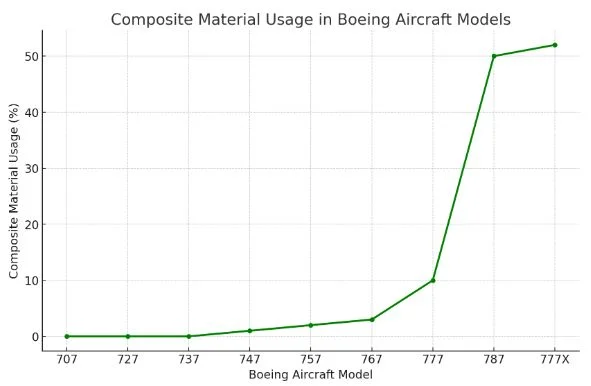
The curve above illustrates the increasing use of composite materials in Boeing aircraft models over time. Starting with minimal usage in earlier models like the 707 and 727, composites became more prominent in the 777 and saw a significant leap with the Boeing 787 Dreamliner, which utilizes around 60% composite materials. This trend continued with the 777X, reinforcing Boeing’s commitment to lightweight, efficient materials in modern aircraft designs.
Advantages of using composite materials in aircraft
Modern aircraft manufacturers increasingly favor composite materials over traditional metals like aluminum for several key reasons:
1. Weight Reduction
Composite materials, especially carbon fiber reinforced polymers (CFRP), offer an outstanding strength-to-weight ratio. Compared to aluminum, which has been a long-standing choice in aviation due to its lightweight and corrosion resistance, composites are even lighter. This weight reduction allows for greater fuel efficiency, higher payload capacity, and reduced operational costs. For airlines, fuel is a significant expense, so lighter planes lead to substantial savings and reduced emissions.
2. Strength and Durability
Composites have high tensile strength and excellent fatigue resistance, meaning they endure stress without deforming permanently. They can also handle repetitive loading cycles better than metals, which is critical for aircraft subjected to constant pressurization and depressurization. This ability to withstand high stress and repeated loading cycles without cracking or weakening enhances the lifespan and reliability of the aircraft structure.
3. Corrosion Resistance
Unlike metals, composites don’t corrode. This resistance to corrosion significantly lowers maintenance needs and extends the life of structural components, particularly in harsh environments or applications where moisture and chemical exposure are common. This advantage is critical for components exposed to the elements, reducing the frequency and cost of corrosion-related repairs.
4. Flexibility in Design
Composites are extremely versatile, allowing engineers to mold them into complex shapes that are difficult to achieve with metals. This flexibility supports more aerodynamic designs, which can improve aircraft performance by reducing drag. For instance, the smooth, uninterrupted contours seen on the Boeing 787 or Airbus A350 are possible due to composites, allowing for more efficient and streamlined shapes.
5. Reduced Component Count
Composite materials can be manufactured as large, single pieces, reducing the number of fasteners and joints. Traditional metal aircraft require thousands of rivets, fasteners, and seams, each representing potential weak points or maintenance needs. Fewer joints simplify the structure and reduce maintenance requirements, as fewer components mean fewer points of failure or wear over time.
6. Improved Environmental Impact
Using lighter composite materials directly reduces fuel consumption, leading to lower carbon emissions per flight. Additionally, the longer life span and reduced maintenance needs contribute to a smaller environmental footprint over an aircraft’s lifecycle. Innovations in recyclable thermoplastic composites further enhance the sustainability of composite-based designs, supporting the industry’s move towards more eco-friendly practices.
Limitations of composite materials in aircraft structure
Despite the many advantages of composite materials in aircraft, there are some significant limitations and challenges that manufacturers and operators face:
1. High Production Costs
Composite materials, especially carbon fiber, are expensive to produce and require specialized manufacturing processes. The production process involves laying up multiple layers of composite fabric, curing in an autoclave, and often requires costly machinery and specialized expertise. This makes composite structures more expensive to produce than traditional metal parts.
2. Complex Repair and Maintenance
Unlike metals, composites do not exhibit visible signs of fatigue or cracks in the same way. Damage to composites can be internal (like delamination) and harder to detect without specialized inspection equipment. Repairing composites is also more complex, as it often requires bonding, curing, or replacing entire sections, which can be time-consuming and costly compared to patching metal.
3. Sensitivity to Impact and Damage
While composites are generally strong, they can be sensitive to impact damage, especially from tools, debris, or accidental ground handling incidents. Small impacts may cause internal delamination, reducing the material’s structural integrity without visible signs on the surface, making inspection crucial.
4. Limited Recycling Options
Recycling composite materials remains a challenge. Thermoset composites, which are the most commonly used in aircraft, cannot be reshaped or melted down for reuse. While some recycling methods exist, they are typically complex and not widely implemented. Thermoplastic composites are more recyclable, but they’re less commonly used in large structural components due to performance limitations.
5. Temperature Sensitivity
Composites are generally more sensitive to high temperatures than metals, which can be an issue in applications exposed to extreme heat. This limits their use in certain high-temperature zones of aircraft, such as near engines. For this reason, aluminum, titanium, and other metals are still used in high-stress or high-temperature areas where composites would degrade or lose strength.
6. Manufacturing Limitations for Large Structures
Producing large composite structures, such as wings and fuselage sections, requires huge autoclaves and advanced equipment for precision and uniformity. This infrastructure is capital-intensive and can be a bottleneck, limiting the scalability of composite manufacturing and posing a barrier for smaller manufacturers.
7. Longer Certification and Development Times
Aircraft built with a significant amount of composite materials often face longer certification processes due to the need to validate the long-term durability, damage tolerance, and safety of these materials under all possible conditions. The development and certification of new composite-based designs can take years, affecting time-to-market.
8. Limited Electrical Conductivity
Unlike metals, composites are poor conductors of electricity, which can pose a problem in aircraft, especially in terms of lightning protection. Manufacturers address this by embedding conductive materials or adding metal mesh to composite surfaces, but these solutions add weight and complexity, partially offsetting some of the weight savings benefits.
Conclusion
In summary, composite materials are revolutionizing modern aviation, offering unmatched benefits in weight reduction, fuel efficiency, and design flexibility over traditional metals. Aircraft like the Boeing 787 and Airbus A350 demonstrate how composites enable lighter, greener, and more aerodynamic designs. Despite challenges like high costs, complex repairs, and recyclability issues, composites are reshaping the future of aircraft.
As technology advances, so does the need for maintenance engineers and aviation enthusiasts to deepen their industry knowledge, paving the way for a future where aviation is more efficient, sustainable, and high-performing.
